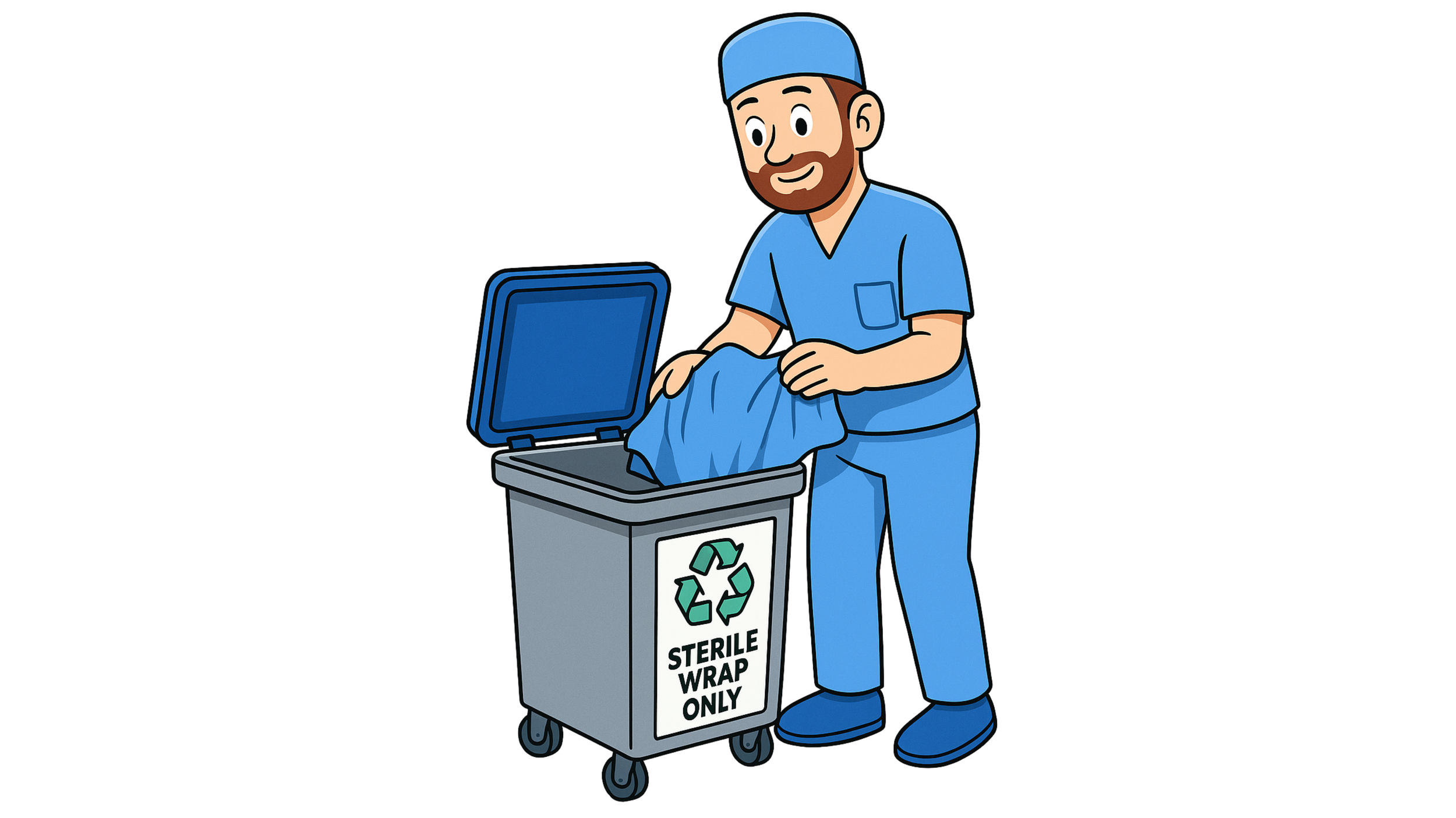A NEW PATH
FOR STERILE
WRAP
IT SAFEGUARDED LIFE IN THE OPERATING ROOM.
NOW, WE’RE GIVING IT A FUTURE THAT PROTECTS OURS.
Hospitals in the U.S. throw away over 255 million pounds of sterile wrap every year. Used once to sterilize surgical tools, this durable, water-resistant polypropylene is tossed before a patient even enters the room. That’s not a niche problem — it makes up nearly 19% of all surgical waste. What if this single-use material didn’t have to be single-purpose?
join the mission to help collect
200,000+ Pounds of Sterile Wrap from Nebraska Hospitals Before It Hits the Landfill
7 Hospitals and counting!

A National Issue.
A Nebraska-Based Response.
At PolyPath, we’re launching a local response in Nebraska by partnering with hospitals, rescuing this overlooked material, and exploring how it can be turned into products with real-world impact. The goal? Prove what’s possible here — and create a model that can scale far beyond.
-

Collection
Identify and designate what bin the sterile wrap will be collected in during surgery set-up. Collect only clean, uncontaminated sterile wrap during surgical setup — before the patient enters the room!
-

Bag, Tie, Remove
Tie off the sterile wrap recycling bag or place a lid over the collection bin and remove it before the patient arrives to the OR. This keeps the material clean and ready for pickup.
-

Store for Pickup
Keep bags in a designated storage area, ideally near a loading dock or utility room. Most hospitals run on a weekly or biweekly pickup schedule based on volume of collection.
-

We Pick Up & Transfer
We’ll pick up the wrap, bale it, and deliver it to recycling partners like Firstar Fiber — where it’s processed down and used to make new products.
pure plastic. untapped potential.
Sterile wrap is a non-woven fabric made from medical-grade #5 polypropylene, a strong, lightweight, and fully recyclable plastic. It’s used once to keep surgical instruments sterile, then discarded—even though it never touches a patient. Because it’s clean, consistent, and high quality, it’s an ideal material to repurpose into durable products across industries. Here’s what we’re exploring:

Personal Story
Howdy! I’m Connor. I was born and raised in Nebraska, and somewhere along the way, I stumbled into a surprising plastic problem.
As an orthopedic sales rep, I spend most days in the operating room. That means I have a front-row seat to a lot of surgeries—and a lot of wasted plastic. Every day, I watch perfectly clean sterile wrap go straight into the trash—unused, uncontaminated, and full of potential.
I started digging into the numbers and realized that hundreds of thousands of pounds of this material are wasted every year in Nebraska alone, just from orthopedic cases.
That’s when I started PolyPath. The goal is simple: collect this high-quality plastic before it hits the landfill, and work with hospitals, innovators, and builders to turn it into something far better than waste.
FREQUENTLY ASKED QUESTIONS
FREQUENTLY ASKED QUESTIONS
1. What is sterile wrap?
Sterile wrap is a high-quality, non-woven polypropylene (#5) fabric used in hospitals to maintain the sterility of surgical instruments prior to surgery. It’s durable, water-resistant, and designed to be used once, then discarded — even though it’s often still clean and uncontaminated.
2. Why is sterile wrap only used once?
Due to FDA regulations and hospital safety protocols, sterile wrap is single-use. The concern is that after going through one sterilization cycle in an autoclave, the material may begin to degrade or develop microscopic tears, which could compromise sterility. For patient safety, it’s standard practice to use a fresh sheet for every procedure.
3. How much sterile wrap is discarded annually?
Hospitals in the United States discard over 255 million pounds of sterile wrap each year. Most of this material ends up in landfills despite being clean and high quality.
4. What is PolyPath doing differently?
We collect clean, uncontaminated sterile wrap from hospitals in Nebraska and explore ways to repurpose or recycle it into valuable products — keeping it out of landfills and in the economy.
5. Is the wrap you collect contaminated?
No, we only collect uncontaminated sterile wrap. We work with hospital staff to ensure best practices are followed, and collection only happens before a patient enters the OR. The wrap is then stored in a designated area and picked up later.
6. Is this the same as the Blue Renew Program?
No. PolyPath is not affiliated with Halyard Health or the Blue Renew Program. We operate independently, though we use publicly available information to inform our recycling processes.
7. Can sterile wrap be reused?
While it’s technically possible, most healthcare providers do not reuse sterile wrap due to safety regulations. Its structural integrity may diminish over time with repeated autoclaving, risking contamination.
8. How do you ensure the wrap stays clean?
We train hospital staff on proper collection protocols. The wrap is separated before any patient interaction, placed in clean holding areas, and stored in non-biohazard bags before being picked up.
9. What type of plastic is sterile wrap made from?
Sterile wrap is made from non-woven polypropylene, classified as #5 plastic. It’s durable, water-resistant, and highly recyclable.
10. Can the wrap be recycled like regular plastic?
Technically yes, but due to its textile-like texture and hospital origin, many recycling centers won’t accept it. That’s where PolyPath steps in to bridge the gap.
11. What products can be made from sterile wrap?
Once processed, sterile wrap can become plastic lumber, home insulation, acoustic panels, tote bags, car parts, and much more — depending on how it’s handled post-collection.
12. How is the wrap stored before it’s picked up?
Hospitals store clean wrap in designated containers or bins in a secure area away from patient contact. It’s only transported in clean, non-biohazard bags.
13. What does the recycling process look like?
Collected wrap is baled and can either be used as is or shredded and melted into polypropylene resin. That resin is then either used to create another product or sold to manufacturers who create new products.
14. Is this process FDA approved?
The wrap we collect is not reused in clinical settings, so FDA approval isn’t required for the recycling pathway we’re exploring. However, we follow strict hygiene and material-handling protocols.
15. What states are you operating in?
Right now, we operate across central Nebraska, with wrap coming from five hospitals. We’re planning to scale to more locations.
16. Do hospitals pay to participate?
No. In fact, we make it easy and cost-free for hospitals to participate. Our goal is to make wrap collection as frictionless as possible.
17. Is the wrap you collect contaminated?
No, we only collect uncontaminated sterile wrap. We work with hospital staff to ensure best practices are followed, and collection only happens before a patient enters the OR.
18. How can companies or manufacturers use this material?
They can buy it in bulk either baled or as reprocessed resin. It’s ideal for manufacturers who need a steady stream of #5 polypropylene for products.
19. How can someone support or get involved?
We welcome connections with Central Nebraska based hospitals, designers, recyclers, sustainability professionals and anyone passionate about reducing waste. Reach out via our website or social media.
20. How do I contact PolyPath?
Visit our website, follow us on Instagram and TikTok (@polypath.med), or email us directly through our contact page. We’re always open to ideas, collaborations, and questions.

HOW YOU CAN HELP:
-
Hospitals:
• Donate unused clean sterile wrap.
• We’ll handle logistics.
• Educational resources available on how to properly collect and store clean wrap. -
Innovators:
• Submit product ideas for how we can repurpose this material.
• Incentives or payments may be offered for viable ideas and customers ready to buy.
-
Supporters:
• Spread the word and share the mission.
• Know someone working in a hospital or creative you think could put these to good use? Send us their contact info.
GOT AN IDEA or Customer?
We’re open to offering compensation for a creative product idea that can turn recycled sterile wrap into something impactful and customer that is ready to buy it!












